Tuesday, June 06, 2006
Give my regards to Broadway
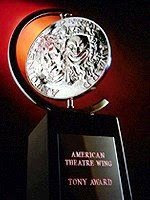
By Josh R
Now that the film awards-giving season is well behind us, and the Emmy nominations won’t be unveiled until July, the attention of awards-watchers like myself turns to the goings-on in the world of Broadway theater. I’m aware that people such as Edward and myself are members of a diminishing breed that actually pay attention to The American Theater Wing’s annual Tony Awards presentation honoring excellence on Broadway — though televised by CBS, the show’s ratings usually fall somewhere between a first-run episode of the least-watched Law & Order spin-off (whichever one that is) and a rerun of Walker, Texas Ranger airing on cable. This is understandable given that very few members of the television audience have actually seen or even heard of the shows and performers in contention. As opposed to films, which are available for viewing just about anywhere, live theater is a site-specific entertainment; either you see it in New York, or you wait for the touring production to make its way to a theater near you — usually sans members of the original Broadway cast.
While all of the media coverage surrounding this year’s Tony Awards seems to center on the non-nomination of Julia Roberts, whose Broadway debut in Three Days of Rain landed with a resounding thud at the Jacobs Theater to the gleefully misanthropic accompaniment of widespread critical guffawing (Clive Barnes of The New York Post likened her stage presence to that of a lamppost), the awards themselves will showcase a variety of interesting and worthwhile productions. This year, I’ve seen eight of the nominated shows, and a ninth off-B’way offering that will be headed to the Great White Way this fall and will doubtless figure prominently in next year’s Tony Awards.
The most celebrated of these is The History Boys, an import from Britain’s National Theater. Written by Alan Bennett, best known to American audiences for his play The Madness of King George (and its subsequent Oscar-nominated film adaptation starring Nigel Hawthorne), the play has received the kind of glowing notices that usually guarantee a production automatic commercial success and a long life beyond Broadway. Indeed, The History Boys has sold out its entire limited New York run, and a film version already has been made by Nicholas Hytner (who also directed this production), which may be released as early as this fall. It’s regarded as the prohibitive frontrunner in the best play category, and deservedly so.

As with any work of theater which takes on complicated issues, the plot is difficult to summarize. Basically, the story centers on a group of British schoolboys being prepared to take their college entrance exams by two teachers representing radically different approaches to education. The show has drawn some comparison to Dead Poets Society, although beyond their scholastic settings, I don’t think the two have very much in common (it’s a bit like comparing Network to Murphy Brown because they both take place in the world of televised news). History Boys uses this basic premise of a teacher inspiring his pupils as a jumping off place to tackle some thorny and provocative issues about the modern cultural approach to learning, and the way that institutional education can be damaging to those who seek to gain from it. The two teachers — played by Richard Griffiths (known to fans of the Harry Potter series as the title character’s portly muggle uncle) and Stephen Campbell Moore (Bright
 Young Things) — personify two radically different approaches to education. One represents the idea of learning for its own sake, the other views education as a commodity that can be parlayed into status, something to be used and exploited rather than to be enlightened by. The school's headmaster favors the latter approach since it produces "quantifiable" results — high test scores and Oxford scholarships. He prioritizes the well-being of the institution, and the prestige its pupils can bring to it, above the best interests of the people the institution exists to benefit — many critics have observed how this aspect of the play is really a metaphor for the self-serving politics of Thatcherite England (it's no accident that the play is set during Thatcher's tenure as prime minister). The "History Boys" are emerging from their education with a wealth of knowledge, but without any sense of how to apply it toward some meaningful purpose — all Moore's character has taught them how to do is to make flashy, subversive intellectual arguments that make them desirable to top universities. The scene where his character encourages his students to rationalize The Holocaust is chilling — it doesn't matter whether the students believe what they're saying or not, since (to Moore's way of thinking) perception is valued above truth.
Young Things) — personify two radically different approaches to education. One represents the idea of learning for its own sake, the other views education as a commodity that can be parlayed into status, something to be used and exploited rather than to be enlightened by. The school's headmaster favors the latter approach since it produces "quantifiable" results — high test scores and Oxford scholarships. He prioritizes the well-being of the institution, and the prestige its pupils can bring to it, above the best interests of the people the institution exists to benefit — many critics have observed how this aspect of the play is really a metaphor for the self-serving politics of Thatcherite England (it's no accident that the play is set during Thatcher's tenure as prime minister). The "History Boys" are emerging from their education with a wealth of knowledge, but without any sense of how to apply it toward some meaningful purpose — all Moore's character has taught them how to do is to make flashy, subversive intellectual arguments that make them desirable to top universities. The scene where his character encourages his students to rationalize The Holocaust is chilling — it doesn't matter whether the students believe what they're saying or not, since (to Moore's way of thinking) perception is valued above truth.The production has transferred from the 2005 National Theatre incarnation with its original cast intact. Griffiths, a marvelous character actor who handles both the play’s comic and tragic elements with equal aplomb, is likely to win best actor for his performance as the eccentric Hector — a maverick teacher in the Jean Brodie mold who isn’t above making inept advances toward his students when he’s not having them act out scenes from Now, Voyager and Brief Encounter. Frances de la Tour also is considered a strong contender in the featured category for her delightful deadpanning as Mrs. Lintott, who serves as the play’s wry, wary voice of reason, while young Samuel Barnett is nominated in the featured actor category as Posner, a desperately insecure student nursing a painful crush on his classmate, Dakin, played by Dominic Cooper. All five of the actors (Griffiths, Campbell Moore, de la Tour, Barnett, Cooper) were nominated for Drama Desk Awards — the Tony-nominated troika all won in their respective categories.

Just as it was beginning to look as if no new play could generate as much heat as the Bennett offering, an unlikely new entry arrived on the scene to rival The History Boys for critical enthusiasm. Irish playwright Martin McDonagh first achieved widespread recognition on Broadway for his 1998 critical and commercial hit The Beauty Queen of Leenane, a sort of Celtic variation on Whatever Happened to Baby Jane? with a mother and daughter wreaking havoc on each other’s lives in epic Grand Guignol fashion. Known for his penchant for shock value — startlingly violent imagery delivered with a twist of black humor — the playwright has been prolific in the years since, garnering four nominations in the best play category and winning an Oscar this past March for his short film, Six Shooter. His latest, The Lieutenant of Inishmore, has settled in for what appears to be a long run at the Lyceum Theater after an acclaimed engagement at off-Broadway’s Atlantic Theater Company.
Beauty Queen of Leenane is the only other work of McDonagh’s I’ve seen, and even though I had reservations about the play as a whole, I couldn’t help being impressed by the author’s undeniable talent and nerve; The Lieutenant of Inishmore, which is doubtless one of the outrageous spectacles
 ever to be presented on a Broadway stage, is a much more ambitious and impressive piece of work, and infinitely more satisfying. A sociopathic IRA gunman, played to the hilt by the charismatic Irish actor David Wilmot, leaves his cherished pet cat, Wee Thomas, in the care of his belligerent father (Peter Gerety), who is too fearful of his son’s wrath to decline the responsibility. When Wee Thomas meets his untimely demise, ostensibly at the hands of a dull-witted teenager on a bicycle (Tony-nominated Domhnall Gleeson), it sets off a bloody chain of events that is both appallingly funny and frighteningly absurd. A brickbat pitched squarely in the direction of the reigning powers-that-be and their disciples, McDonagh’s deliciously twisted take on the senselessness of terrorism exposes (and holds up for ridicule) the sheer lunacy of warfare fought on an ideological basis. The playwright has great fun at expense of his characters’ convoluted politics — they represent various splinter groups (and even splinter groups of splinter groups) and have become so warped by their own crazed rhetoric and wayward sense of moral imperative that they’ve forgotten exactly what the ideological basis of their positions are. No one seems to be able to pin down the specifics of their various agendas — even for the most fervent advocates of a particular cause, the rationale is murky at best. Ultimately, McDonagh suggests, it all just amounts to empty posturing.
ever to be presented on a Broadway stage, is a much more ambitious and impressive piece of work, and infinitely more satisfying. A sociopathic IRA gunman, played to the hilt by the charismatic Irish actor David Wilmot, leaves his cherished pet cat, Wee Thomas, in the care of his belligerent father (Peter Gerety), who is too fearful of his son’s wrath to decline the responsibility. When Wee Thomas meets his untimely demise, ostensibly at the hands of a dull-witted teenager on a bicycle (Tony-nominated Domhnall Gleeson), it sets off a bloody chain of events that is both appallingly funny and frighteningly absurd. A brickbat pitched squarely in the direction of the reigning powers-that-be and their disciples, McDonagh’s deliciously twisted take on the senselessness of terrorism exposes (and holds up for ridicule) the sheer lunacy of warfare fought on an ideological basis. The playwright has great fun at expense of his characters’ convoluted politics — they represent various splinter groups (and even splinter groups of splinter groups) and have become so warped by their own crazed rhetoric and wayward sense of moral imperative that they’ve forgotten exactly what the ideological basis of their positions are. No one seems to be able to pin down the specifics of their various agendas — even for the most fervent advocates of a particular cause, the rationale is murky at best. Ultimately, McDonagh suggests, it all just amounts to empty posturing.The gore in Inishmore is amazingly graphic by Broadway standards, although relatively tame by Hollywood's. McDonagh has cited Quentin Tarantino as one of his influences, and the show’s frequent outbreaks of violence, abounding with gleefully gory imagery executed in a take-no-prisoners fashion, echo the highly stylized bouts of bloodletting on display in the Kill Bill films. Midway through the second act, the carnage starts to amass — the set is strewn with corpses in various states of dismemberment and the walls and floors have been liberally doused with blood. The audience response is one of shock, but there's also a fair amount of giggling — the visual is just so outrageous you can't help but laugh. It’s a brilliantly constructed play given an amazingly kinetic production by Wilson Milam, and I suspect that even the squeamish playgoers will be surprised to find themselves laughing along with the catalog of horrors on display.
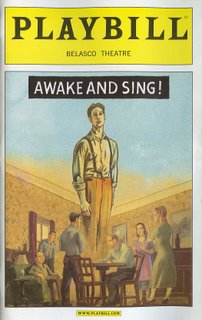
The two other dramatic offerings I’ve seen this year are not quite as successful, although both qualify as worthy endeavors. Lincoln Center Theater serves up a revival of the 1935 social polemic Awake and Sing!, the most celebrated work of playwright Clifford Odets. If you’ve never heard of it, there’s a reason: although regarded as a seminal work, it doesn’t fully measure up to its exalted reputation. Although given an intelligent production by director Bartlett Sher, and expertly performed by a star-studded cast featuring Ben Gazzara, Mark Ruffalo, Zoe Wanamaker and Lauren Ambrose, there’s very little that talent could have done to disguise both the play’s age and its obvious limitations. Written in tough-talking period slang so florid it would make James Cagney blush (clearly these characters hail from the same environs as The Dead End Kids), the play wears its social indignation and political agenda-pushing a little too prominently on its careworn sleeve. The characters, members of a downtrodden Jewish family living in the squalid tenement slums of lower Manhattan, exist as an illustration of the manner in which the proletariat is oppressed by the commercial classes. By the time the idealistic young hero is exhorting his fellow men to till the earth, the combination of hokiness and preachiness has become difficult to accept with a straight face. That said, the production is very well-acted, particularly by Ruffalo as a hard-bitten realist who actually manages to make his slang-heavy dialogue plausible, and by Wanamaker as the matriarch who has been made cynical and grasping by years of struggle and compromise.

 David Lindsay-Abaire’s Rabbit Hole has the rather dubious distinction of being the only work by an American playwright to be nominated in the best play category. The author became something of a critical darling for his unconventional, absurdist off-Broadway comedies Fuddy Meers and Kimberly Akimbo — for his Broadway debut, he apparently decided to make a 180 degree turn into the relative safety of poker-faced realism, and the result feels like a very calculated effort at mainstreaming (notice I didn’t say selling out, because the play is obviously a work of genuine feeling rather than a cynical concession to popular taste). To be fair, Lindsay-Abaire’s talent as a writer is clearly in evidence, which only partially serves to compensate for the rather uninspired subject matter he’s chosen to explore. The play is about two parents coping with the death of a young child and learning how to heal — if that sounds a bit Hallmark Hall of Fame, that’s sort of how it plays. The consummate skill of Cynthia Nixon, who plays the role of the grieving mother, lends emotional credibility to a play that is otherwise bogged down in what often borders on maudlin, movie-of-the-week style dramaturgy, while Tyne Daly contributes a welcome element of humor in a supporting role. Both women are nominated for Tony Awards — Nixon’s prospects for winning lead actress look very good in what is considered a rather weak category. Since Mr. Copeland and I are both card-carrying members of the Cynthia Nixon fan club — my admiration for the actress dating back to her stage work in the mid-'90s (particularly Phyllis Nagy’s avant-garde production of The Scarlet Letter at CSC in 1995), Edward having been in thrall to her charms ever since Sex & The City — this will provide us with a mutual rooting interest.
David Lindsay-Abaire’s Rabbit Hole has the rather dubious distinction of being the only work by an American playwright to be nominated in the best play category. The author became something of a critical darling for his unconventional, absurdist off-Broadway comedies Fuddy Meers and Kimberly Akimbo — for his Broadway debut, he apparently decided to make a 180 degree turn into the relative safety of poker-faced realism, and the result feels like a very calculated effort at mainstreaming (notice I didn’t say selling out, because the play is obviously a work of genuine feeling rather than a cynical concession to popular taste). To be fair, Lindsay-Abaire’s talent as a writer is clearly in evidence, which only partially serves to compensate for the rather uninspired subject matter he’s chosen to explore. The play is about two parents coping with the death of a young child and learning how to heal — if that sounds a bit Hallmark Hall of Fame, that’s sort of how it plays. The consummate skill of Cynthia Nixon, who plays the role of the grieving mother, lends emotional credibility to a play that is otherwise bogged down in what often borders on maudlin, movie-of-the-week style dramaturgy, while Tyne Daly contributes a welcome element of humor in a supporting role. Both women are nominated for Tony Awards — Nixon’s prospects for winning lead actress look very good in what is considered a rather weak category. Since Mr. Copeland and I are both card-carrying members of the Cynthia Nixon fan club — my admiration for the actress dating back to her stage work in the mid-'90s (particularly Phyllis Nagy’s avant-garde production of The Scarlet Letter at CSC in 1995), Edward having been in thrall to her charms ever since Sex & The City — this will provide us with a mutual rooting interest. 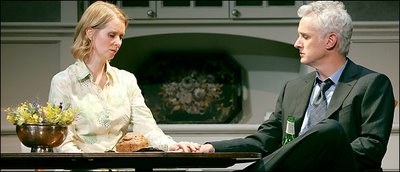
It’s become a favorite pastime of the critics to lament the state of the American musical. Such was the case a few weeks ago, when Ben Brantley wrote what amounted to an obituary for the Broadway tuner in The Sunday Times, summarily dismissing virtually every new show that opened during the 2005-2006 season while measuring them unfavorably against the two hit revivals. The response to the piece within the Broadway community was one of righteous indignation — at the Drama Desk Awards, one of the producers of The Drowsy Chaperone blasted the critic for his comments in his acceptance speech (telling Brantley he “needed to get out more”), to roars of approval from those in attendance — this despite the fact that Chaperone was just about the only new show Brantley didn’t run through the shredder.
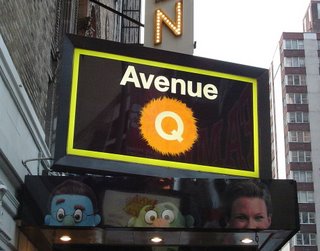
While I appreciate many of Brantley’s points, and would certainly make no attempt to defend any season which inflicted upon the populace the likes of The Wedding Singer and Elton John’s Lestat (which I have not seen, but have heard enough about to steer well clear of), I think it’s a bit premature to sound the death knell for the Broadway musical — if anything, we’ve probably seen an upswing in recent years. Coming off the doldrums of the '90s, a decade which produced only two truly outstanding new musicals (City of Angels and Rent) wedged in between an assortment of qualified successes, outright turkeys, and innumerable revivals, 21st century Broadway has already given us The Producers, The Full Monty, Hairspray, Avenue Q, and The 25th Annual Putnam County Spelling Bee, plus the slight but enjoyably silly romp that is Monty Python’s Spamalot. While tourism-savvy Broadway still churns out a lamentable number of overproduced theme park rides masquerading as theater, or at the other end of the spectrum, cost-effective Lawrence Welk-style revues cobbled together from recycled Billboard hits of yesteryear, there are more interesting and worthy new shows out there today then there were ten years ago. Which is not to say that the Golden Age of the Broadway Musical isn’t already several decades behind us.
This being the case, it’s the revivals that are greeted with the most enthusiasm by contemporary critics, and the current season features two that have each drawn a great deal of praise.
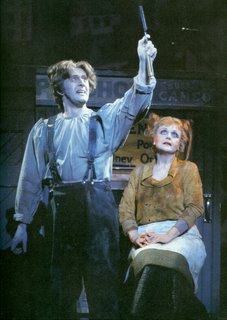
For anyone unfamiliar with Sweeney Todd, The Demon Barber of Fleet Street, I implore you on bended knee to put the American Playhouse filmed version of the stage production — featuring the show’s original star, Angela Lansbury — at the very top of your Netflix queue. If you don’t have Netflix (or something comparable), then take out your credit card credit card and buy the damn thing on amazon.com (or something comparable). And if you don’t have a credit card, steal one. It’s one of the two or three greatest works ever created for the American musical theater, and even you don’t like musicals, you’ll like this one. Either that, or you’ll have forfeited the right to consider yourself a person of taste (sorry, but there are some things I can’t be practical about, and Sweeney Todd is one of them).
I can’t do full justice to the intricately devised plot of the show without testing the patience of anyone reading this, but I’ll try to sum it up as best I can: in a nutshell, the show is based on a penny dreadful — the 18th century equivalent of the kind of grisly tales kids swap around campfires — about a demonic barber in the slums of Victorian England who kills his clients and sends their bodies to his sweetheart, the owner of an establishment which makes and sells meat pies. Which implies exactly what you think it does. Composer-lyricist Stephen Sondheim and librettist Hugh Wheeler tweaked the formula by fashioning their adaptation of the gory legend as a meditation on social inequity. It’s a classic revenge fantasy in which the haves, the people who have power and abuse it, get the comeuppance they deserve for shitting all over the have-nots. These tyrants, men of wealth and consequence who take gross liberties with the privileges birth and status have given them, are served to the victims of their oppression on a plate. Literally. In this version of events, Sweeney Todd, a poor barber, is framed for a crime he didn’t commit by a corrupt judge who covets his beautiful young wife. Sweeney is conveniently dispatched to a penal colony in Australia — he returns under an assumed identity many years later to be told of how his wife suffered at the hands of his nemesis, and subsequently committed suicide. This barber doesn’t kill people merely because he gets a kick out of it — unhinged by bitterness and grief, he seeks to exact revenge on those who ruined his life. When he meets up with the cheerfully amoral Mrs. Lovett, a wily opportunist with the good sense to utilize his bloodlust to maximize her profit margins, the diabolically enterprising team successfully convert half the population of London into unwitting cannibals.
 Hal Prince’s legendary 1979 staging was an elaborate spectacle done in period style with Victorian sets and costumes — most subsequent productions, though perhaps more modest in scale, haven’t made a radical departure from this template. John Doyle, who helmed the current Broadway revival, has opted for an entirely different approach — and to call it a radical departure would be an understatement. It’s a boldly minimalist staging which forgoes any attempt at realism — for starters, the actors double as the orchestra (the effect really has to be seen to be appreciated, but it involves some logistically complex stagecraft and dextrous multi-tasking by the cast). The production style is non-period-specific, and decidedly avant-garde; for those unfamiliar with the story, certain things may be a bit confusing, since this is not a literal-minded representation of the action. For example, each murder, rather than being acted out, is indicated when the actors pour quantities of blood from one bucket into another. The cast of ten actors double and triple in various roles without much in the way of costume changes, and often in ways the defy the specifications of gender or age. It’s a very conceptual approach, and one
Hal Prince’s legendary 1979 staging was an elaborate spectacle done in period style with Victorian sets and costumes — most subsequent productions, though perhaps more modest in scale, haven’t made a radical departure from this template. John Doyle, who helmed the current Broadway revival, has opted for an entirely different approach — and to call it a radical departure would be an understatement. It’s a boldly minimalist staging which forgoes any attempt at realism — for starters, the actors double as the orchestra (the effect really has to be seen to be appreciated, but it involves some logistically complex stagecraft and dextrous multi-tasking by the cast). The production style is non-period-specific, and decidedly avant-garde; for those unfamiliar with the story, certain things may be a bit confusing, since this is not a literal-minded representation of the action. For example, each murder, rather than being acted out, is indicated when the actors pour quantities of blood from one bucket into another. The cast of ten actors double and triple in various roles without much in the way of costume changes, and often in ways the defy the specifications of gender or age. It’s a very conceptual approach, and one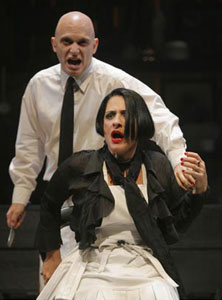 which produces very satisfying effects, although the lushness of Sondheim’s complex and melodic score is somewhat lost without the benefit of a full orchestra. If there’s anything missing from this production, it’s the element of gleeful black humor that Sondheim, Wheeler and Prince used in the original to balance out the bleak nature of the subject matter. The original Sweeney was blissfully funny, due in no small part to the performance of Angela Lansbury as the delightfully grotesque Mrs. Lovett. While her broadly comic creation was informed by the classic traditions of the English music hall (which involves plenty of mugging and exaggerated mannerism), the Mrs. Lovett of Patti LuPone is decidedly subdued, more hard-bitten pragmatist than Grand Guignol cut-up. What this does, in effect, is to rob the show of the required element of comic relief, a necessary function the character must serve in order to keep things from getting too depressing (which is exactly why Sondheim and Wheeler conceived the character in a comic vein). Still, the actress is widely considered the favorite to win her second Tony for the performance — her first having come for playing the title role in the 1980 Broadway premiere of Evita.
which produces very satisfying effects, although the lushness of Sondheim’s complex and melodic score is somewhat lost without the benefit of a full orchestra. If there’s anything missing from this production, it’s the element of gleeful black humor that Sondheim, Wheeler and Prince used in the original to balance out the bleak nature of the subject matter. The original Sweeney was blissfully funny, due in no small part to the performance of Angela Lansbury as the delightfully grotesque Mrs. Lovett. While her broadly comic creation was informed by the classic traditions of the English music hall (which involves plenty of mugging and exaggerated mannerism), the Mrs. Lovett of Patti LuPone is decidedly subdued, more hard-bitten pragmatist than Grand Guignol cut-up. What this does, in effect, is to rob the show of the required element of comic relief, a necessary function the character must serve in order to keep things from getting too depressing (which is exactly why Sondheim and Wheeler conceived the character in a comic vein). Still, the actress is widely considered the favorite to win her second Tony for the performance — her first having come for playing the title role in the 1980 Broadway premiere of Evita.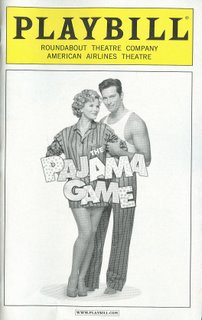
Whereas this production of Sweeney is defiantly nontraditional, the season’s other musical revival of note is decidedly square…which makes it no less of a triumph. The Pajama Game is the kind of kitschy, cornball entertainment that probably seemed clever and witty back in 1955 — by modern standards, it’s about as sophisticated in its attitudes as Pillow Talk, the squeaky-clean sex comedy of 1959 starring Rock Hudson and Doris Day (it’s no accident that Day top-lined the 1957 film version of The Pajama Game). It’s a cute boy-meets-girl tale set in a pajama factory — since the course of true love never did run smooth, she’s a union agitator, he’s management. A proposed strike presents an obstacle to their romance — boy loses girl, boy gets girl back.
It’s the kind of sappy, precious material that really has no business working in a contemporary context — but never underestimate what a great chef can do with day-old bread. Nearly everything about the production confounds expectation; credit director-choreographer Kathleen Marshall (sister of filmmaker Rob) for sprucing up an old chestnut with style and verve. Her crackerjack production succeeds in making The Pajama Game seem less trite and coy than it actually is, while still managing to stay absolutely true to the spirit of source material. This is due in no small part to the presence of Harry Connick Jr., making a remarkably polished and assured Broadway debut as the show’s romantic lead. In additional to his sublime vocals, which capture the full vintage flavor of the Adler and Ross score, he creates a wonderful chemistry with golden-voiced leading lady Kelli O’Hara, who has an astute, knowing quality which gives her wholesome girl-next-door character a nice bit of an edge. The interplay between the two recalls classic scream teams like Hepburn & Tracy and Bogart & Bacall — it’s smart, sexy, and when they spark, it strikes just the right balance between sophistication and playfulness. The show has a lock on only one Tony (for best choreography), and looks likely to come up short in all the other categories in which it’s nominated. Still, if the production can only take home one award, it’s only right that Marshall’s dance routines should be the beneficiary. Worthy of special mention are her dizzy "Once-a-Year-Day" ballet, a nifty nod to the Fosse style with "Steam Heat", and above all, a dazzlingly staged and executed "Hernardo's Hideway" which weaves Connick's piano-playing skills seamlessly (and quite ingeniously) into the fabric of the dance.
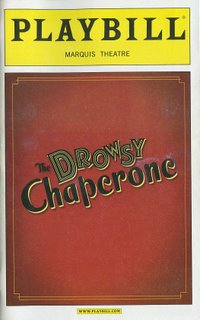
One show that is canny enough to exploit the gap between the heyday of Cole Porter and what often passes for musical theater today has become the heavy favorite to win best musical. Instead of operating on the pretense that the state of contemporary musicals is right as rain, the show emphatically and hilariously insists that the celebrated hit of today doesn’t even stack up to yesterday’s mediocrity. The central character, billed only as Man in Chair, opens by the show by telling us he hates theater (“Well, it’s always so disappointing isn’t it…please, Elton John, must we continue with this charade?”). A middle-age musical theater buff of indeterminate sexuality and multiple neuroses, The Man holds court from his cluttered studio apartment, treating the audience as his guests and extolling the virtues of his favorite 1920s musical. The show is The Drowsy Chaperone, a madcap romp involving a dewy-eyed heroine, her stalwart suitor, a tippling grand dame, a dithery socialite, a supercilious butler, an anxious Broadway producer and a pair of gangsters who crash a wedding and pose as pastry chefs — the kind of frothy, featherweight concoction that was Broadway’s stock-in-trade during the era of Ziegfeld pastiche. The twist is that while Man in Chair plays the album for us, the show comes to life before our very eyes in his apartment (with various characters making their entrances from out of the refrigerator or whatever other ports of entry are available). The narrator doesn’t dematerialize, nor is he magically transported inside the show to become a participant, ala The Purple Rose of Cairo. Instead, he sits on the sidelines, commenting on what we’re seeing, offering amusing bits of trivia about the actors (for example, one earned the moniker The “Oops” Girl for her ability to cause men to suffer accidents, while another was apparently found dead in his Italian villa partially devoured by his own poodles), and occasionally singing along when not apologizing to the audience for parts of the show that are more ludicrous than others (“please do your best to ignore the lyrics and enjoy the melody” he says of a torch song that employs the awkward metaphor of monkey love to describe a relationship gone sour). I’m always slightly skeptical of shows built around a gimmick; but the witty conceit that provides the basis of The Drowsy Chaperone proves disarmingly effective — especially when it allows for riotously funny bits of business as a dance sequence that goes slightly amiss when the record begins to skip, or the moment when The Man inadvertently plays the record from a different show when changing LPs before going off on a bathroom break (what we get is a hilariously racist song from another 1920s show bearing a striking resemblance to The King and I).

As Ben Brantley observes in his review, the show-within-a-show isn't as good as The Man's running commentary, but the flaw is hardly fatal. The music and lyrics, by a novice team, are undistinguished, but the libretto is strong throughout. Bob Martin is wonderful in the lead, while Sutton Foster makes the most of her two show-stopping numbers (one of which features her jumping through hoops, juggling plates, throwing her voice, and doing cartwheels while insisting she doesn’t want to be the center of attention). Beth Leavel, who plays the title role as a martini-soaked grand dame, is the heavy frontrunner in the featured actress category — that said, the performance is way too broad for my taste and the shtick wears thin rather quickly.
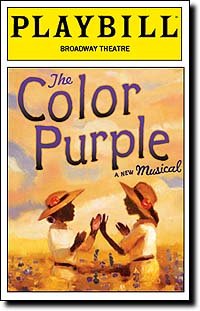
Needless to say, of all works of contemporary fiction, Alice Walker’s Pulitzer Prize-winning The Color Purple has always been the second most obvious candidate for adaptation into a crowd-pleasing Broadway musical (the first, I’m sure we can all agree, being The Bonfire of the Vanities). Produced for the stage by the all-powerful multimedia conglomerate known as Oprah, who not un-coincidentally played the role of Sofia in Steven Spielberg’s 1985 cinematic version, the show actually works better than one might expect — which is not to say that it was ever a good idea in the first place. This Color Purple seems to draw the bulk of its inspiration from the Spielberg film rather than the source novel; this being the case, it shares many of the movie’s flaws. It was always somewhat disheartening for lovers of the novel to see the mood created by Walker’s spare, gritty prose jettisoned in favor of a heartwarming, candy-colored tearjerker populated by exaggerated stereotypes. The show attempts to replicate the effect, and just as the film did, tries to shoehorn too many narrative threads into an overly condensed format. Still and all, it works on the level of entertainment, and provides two and half hours of pleasant, if ultimately unmemorable, diversion. The standouts from the large cast are Felicia P. Fields as the brash Sofia, Elisabeth Withers-Mendes as the sensual Shug, and the lumnious LaChanze, who navigates Celie's transition from meek acquiescent to independent spirit much more convincingly than Whoopi Goldberg did. Since the combination of brass lungs and power ballads usually carry some weight with voters (as was the case when Idina Menzel’s strenuous vocal pyrotechnics in Wicked helped her to vault past Donna Murphy and Tonya Pinkins two years ago), LaChanze's powerfully sung performance considered a strong contender for the win.

The most interesting and ambitious new musical I’ve seen this past year is Grey Gardens, which played a limited engagement at Playwright’s Horizons in preparation for a Broadway run. I’ll have a lot more to say about the production and the cult documentary film on which it is based when the show opens at the Walter Kerr Theater in the fall. The performance given by the production’s lead actress, Christine Ebersole, may qualify as the best I’ve seen on any stage this year, and would surely be considered a strong contender for a Tony if off-Broadway productions were eligible for consideration. The Tonys are produced by The League of American Theatres and Producers (jointly with the American Theatre Wing). As many critics of the Tony Awards have observed, the Broadway producers are resistant to the inclusion of off-B'way productions; as far as they're concerned, the Tonys exist first and foremost as an opportunity to promote their own product, to the exclusion of all else. That being the case, the nominations don't represent a fair sampling of what the season has to offer; Broadway shows account for only a small percentage of the productions that open each year. In view of these circumstances, one might be justified in viewing the Tony Awards as more of an industry trade show than a merit-based competition. But that’s a discussion for another day….and besides, even if you know the thing is rigged, it doesn’t make it any less fun to watch.

In speaking with friends about shows I've seen, I’ve encountered many cynics who assert that theater is no longer relevant as popular culture (we call these people philistines…just kidding). It doesn’t seem as if many younger actors of my acquaintance even aspire to be stage performers; the perception seems to be that theater is something you do to hone your craft while waiting for the big break to materialize — a launchpad to film and television work. It’s true that, in an age dominated by electronic media, the audience for theater has shrunk considerably. Broadway doesn’t have the same kind of prominence that it once did, when stage-based performers such as Mary Martin or Ethel Merman could attain the status of household names, or a new discovery such as Barbra Streisand or Carol Burnett could become an overnight sensation based on a Broadway success. People of my parents’ generation grew up with an awareness of theater — the original cast recording of My Fair Lady, for example, was one of the best selling albums of its year, and its score was almost universally heard and enjoyed even before the Warner Bros. film adaptation arrived on the scene. It’s hard to imagine something like that happening today, when instances of Broadway productions blossoming into pop culture phenomena are few and far between (the Lloyd Webber shows of the '80s may come the closest). But for those who are willing and able to take the time to look, the pleasures that this art form still affords are undeniable and, I would suggest, vital. Live theater can still take you places that movies and television never could. So if you can make it to New York, for gosh sakes, see a Broadway show — it’ll only cost you an arm and a leg. Which doesn't seem like too much of a sacrfice when you consider what certain characters in The Lieutenant of Inishmore and Sweeney Todd have to part with.
Tweet
Labels: Bacall, Bogart, Cagney, Cole Porter, Cynthia Nixon, Doris Day, Fosse, Julia Roberts, K. Hepburn, Lansbury, Law and Order, Musicals, Rock Hudson, Sondheim, Spielberg, Streisand, Tarantino, Theater
Comments:
<< Home
Well done Josh. As always, I wish I could have seen some of these, especially my beloved Cynthia.
I did see two of McDonagh's plays -- Beauty Queen and The Lonesome West. I liked them both, but I preferred Beauty Queen.
I did see two of McDonagh's plays -- Beauty Queen and The Lonesome West. I liked them both, but I preferred Beauty Queen.
Oh and I neglected to say that I didn't see Lt. of Inishmmore but for me McDonagh's PILLOW MAN was THE play of the year last season. I'm disappointed that the simpler and less ambitious DOUBT won the prize.
Post a Comment
<< Home

